The Palais-de-Chaillot and Trocadero Gardens are located on Chaillot hill in the 16th district of Paris. It was built for the 1937 Exposition Universelle in place of the Palais du Trocadero which had been built for the 1878 World's Fair. Only the name "Trocadéro" has remained for the gardens that surround the Palais de Chaillot today.
The long history of Chaillot Hill
A building, "l'Hermitage" or "Maison de Beauregard", was acquired in 1583 by Queen Catherine de Medici. In the seventeenth century, the premises were part of the estate of the Marshal de Bassompierre, companion in arms of king Henri IV, who enlarged the manor.
The castle was acquired again in 1651 by the nuns of the convent of the Visitation Sainte-Marie on the initiative of Henriette of England who was to be buried there. This convent, abandoned at the beginning of the French Revolution, was destroyed in 1794 by the explosion of the explosive manufacturer of Grenelle.
In 1811, Emperor Napoleon 1st decided, one month before the birth of his son, to build on the site "the palace of his son, the King of Rome". It was to be the center of an administrative and military imperial city. Its construction was abandoned before beginning, as a consequence of Napoleon's military setbacks.
Note on our self-guided walks
We have programmed several self-guided walks of one to 3 km available at any time on your phone. One of the walks that starts at the nearby Eiffel Tower and goes to the Arc de Triomphe passes by the Palais de Chaillot. If you wish to join this itinerary click on "Eiffel Tower to Arc de Triomphe Walk "
This Visiting-Paris-by-yourself service includes about twenty walks whose starting points are always at the exit of the great monuments and museums, such as the Louvre, the Arc de Triomphe, etc. See the list here. You'll be amazed at how much these guided walks can help you in your Parisian peregrinations!
Seventy years of projects, no realization
Under the July Monarchy, (King Louis-Philippe), it was proposed to erect the tomb of Emperor Napoleon 1st there, before his ashes found their place at the Invalides.
In 1841, a colossal statue of the Emperor, 30 meters high, was also considered.
In 1848, sculptor Antoine Etex proposed a monument to Liberty.
In 1858, he projected something else: a "monumental lighthouse or fountain" in the center of a circular square that housed the imperial palace (of Napoleon III this time) and the hotels (buildings) of the ministries.
In 1868, Hector Horeau came with a new project for a colossal statue of "intelligent France enlightening the world". That alone!
But none of these were realized. The land where the present Trocadero Gardens now stand remained fallow until 1876.
Trocadéro: why a Spanish name in the center of Paris?
The name "Trocadero" comes from the Trocadero fort, which defended the Spanish port of Cádiz (Spain). On August 31, 1823, it was captured by the French expeditionary force commanded by the Duke of Angouleme (son of the French King), who had been sent to restore King Ferdinand VII to his Spanish throne.
The original Trocadero Palace
The Trocadero Palace (not to be confused with the current Palais de Chaillot which succeeded it) was built for the Universal Exhibition of 1878 on plans of Moorish and neo-Byzantine inspiration.
The Palais du Trocadéro was not intended to go beyond the 1878 Exposition but finally survived. It saw the Universal Exhibitions of 1889 and 1900, whose installations are mostly spread below on the Champ-de-Mars (the most notable being the Eiffel Tower, also built initially to last only the time of the exhibition of 1889 - but it is still there!).
During the 1900 exhibition, the pavilions of the French colonies and protectorates were installed in the gardens of the palace and the Iena Bridge was "widened by means of wooden sidewalks". It was completely enlarged in 1935, from 14 to 35 meters) in order to link the Colline de Chaillot to the Champ-de-Mars where the rest of the exhibitions were held.
The Palais-de-Chaillot and Trocadero
Before the 1937 World's Fair, the Palais du Trocadéro was destroyed and replaced by the current Palais-de-Chaillot and Trocadero Gardens, which kept part of its framework and the configuration of two semi-circular wings.
The general structure became reinforced concrete, the load-bearing piers were lined with millstones, and the floors were made of reinforced concrete slabs. The new project is representative of a refined and neoclassical style known as "inter-war".
Of course, there was some controversy because some people wanted to keep the existing palace. The architect chose not to rebuild a massive monument that would have had trouble "to exist" facing the Eiffel Tower. He replaced the old dome with a central void and covered the old building with a neoclassical facade that is sober and imposing, typical of the 1930s. The decoration was entrusted to 71 painters and sculptors representing all the art trends of the time. Its was named Palais-de-Chaillot and Trocadero for the gardens around.
The style of the new palace is also called "monumentalist neo-classical". The surface area of the new palace was increased to 41,000 m2, compared to 17,000 m2 previously. The new esplanade is 125 meters long and 60 meters wide.
The 1937 World's Fair and the outbreak of World War II
During the 1937 exhibition, the pavilions of the guest powers were installed in the gardens. The USSR pavilion, on the side of the Passy wing (south side), features the statue "The Worker and the Kolkhozian" by sculptor Vera Mukhina. On the opposite side, the German pavilion of the Third Reich is surmounted by a "golden eagle perched on a swastika," designed by Albert Speer.
Between the two, in the perspective of the palace and the Eiffel Tower, located on Trocadero Square, stands the Column of Peace, designed by Frenchman Albert Laprade.
For the first time, electricity is being used massively, creating a popular night-time attraction on Chaillot hill.
The French Revolution recall in these troubled times
During a national unity celebration on July 14, 1939 (War was declared on September 3, 1939) the Palais-de-Chaillot and Trocadero gardens was used as a setting for the commemoration of the French Revolution of 1789 and the Fête de la fédération of 1790. It was also on the Champ-de-Mars, on the other side of the Iéna bridge, where these two events took place 149 years earlier.
The Occupation of France by Germany, the Palais de Chaillot Palais-de-Chaillot and Trocadero Gardens
On June 23, 1940, after the German invasion of France, Führer Adolf Hitler and his military entourage walked through the Trocadero esplanade to admire the Eiffel Tower and l'Ecole Militaire. He then planned to make a copy of it in Berlin for the future "Welthauptstadt Germania". A project that was eventually abandoned. A ceremony was also organized on June 22, 1943, to mark the beginning of Operation Barbarossa (German invasion of the USSR).
The liberation of France, the hopes of the post-war period
An anti-aircraft gun was installed by the allied troops the day after the Liberation of Paris in the large basin of the fountain in the Trocadero garden.
On July 25, 1945, the national funeral of the writer Paul Valéry was organized there: the "catafalque in the colors of France" placed on the esplanade received "military honors and the meditation of the population". During the Occupation, Paul Valéry, refusing to collaborate with the new regime, delivered the eulogy of the "Jew Henri Bergson" (Philosopher) in his capacity as secretary of the French Academy.
The UN headquarters at the Palais-de-Chaillot and Trocadero
The United Nations, which was created in 1946, held two sessions of its General Assembly at the Palais-de-Chaillot and Trocadero the 3rd (September-December 1948) and the 6th (November 1951-February 1952). In this period, almost all UN institutions did not have definitive seats. The palace benefited from a temporary extraterritoriality exception.
During this 3rd session, on December 10, 1948, the General Assembly adopted the Universal Declaration of Human Rights.
In 1951, in order to host the sixth General Assembly, other temporary prefabricated buildings of 25,000 square meters were installed. They were on the esplanade up to the current Avenue des Nations Unies and around the fountain. This will be the last session of the General Assembly before its final transfer to New York.
Palais-de-Chaillot and Trocadero: the NATO headquarters
Between April 28, 1952, and December 15, 1959, the Palais de Chaillot also housed the headquarters of NATO (which was later transferred to the current building of the University of Paris-Dauphine).
On October 23, 1954, the protocol for West Germany's accession to NATO was signed at the Palais de Chaillot.
To commemorate the place, the President of the French Republic François Mitterrand also renamed the esplanade "Parvis des droits de l'homme" on May 30, 1985.
The style of construction of the Palais-de-Chaillot - the symbols
Of monumental style, the Palais de Chaillot has been criticized, especially in the post-war period, for being close to totalitarian architecture. This is to be put into perspective with the Parisian stay, in June 1940, of Adolf Hitler, who had visited the building and expressed his admiration.
One must also perhaps see the influence of the recent arrival in France (1936) of the left-wing Popular Front government. The 1937 Exposition was then relatively modified in a left-leaning attitude, with the addition of new pavilions (for the Universal Rally for Peace, the World Women's Committee, French associations for the LDS, and veterans' groups). In 1935, Paul Rivet, the first elected representative of the Popular Front, was behind the creation of the Musée de l'Homme at the Palais de Chaillot.
The museum district around the Palais-de-Chaillot and Trocadero
The Palais de Chaillot is already home to several museums, including the Musée de l'Homme, de la Marine in its west wing, the Théâtre national de Chaillot, and the Cité de l'architecture et du patrimoine in its east wing (Museum of French Monuments, Chaillot School and French Institute of Architecture).
But other museums are located nearby: the National National Museum of Asian Arts Museum of Asian Arts - Guimet, the Museum of Modern Art of the City of Paris, Palais Galliera, Fashion Museum of the City of Paris, and the Clemenceau Museum. The Museum of Cinema was opened by Henri Langlois in the 1970s and reopened in 2005 in the 12th arrondissement.
The Franco-American and Universal Friendship District
The places surrounding the Palais de Chaillot are for many linked to Franco-American friendship (rue Benjamin-Franklin and statue, a monument to Admiral de Grasse, steles to the French dead at the Battle of Yorktown, a statue of George Washington on Place d'Iéna, Place des États-Unis - since 1881 - and Place Rochambeau - since 1934 - as well as avenue du Président-Wilson).
After the Second World War, it is also universal friendship that is emphasized. The names of foreign rulers and places are used in the choice of alleys in the palace gardens (1932: Albert I of Monaco, 1951: Gustav V of Sweden, 1952: United Nations, 1945: New York Quay - formerly Tokyo -, Warsaw Square, Hussein I of Jordan).
Under Valéry Giscard d'Estaing, Place du Trocadéro became "Place du Trocadéro-et-du 11-Novembre" (To recall the 1918 armistice of the 1st World War) and under François Mitterrand the esplanade "Parvis des Libertés-et-des-Droits-de-l'Homme". To each Président his own vision of the world.
Trocadero Gardens and the overlook from the Esplanade
The view from the Trocadero esplanade is one of the most majestic tourist sites in France, home to gardens, ponds, architectural treasures, and exceptional museums.
The Trocadero Gardens surround the Palais de Chaillot and overlook the Seine, the Eiffel Tower, and a little further l'Ecole Militaire. They cover an area of 93,930 m2. This garden was created for the 1937 Specialized Exhibition on the site of the former garden of the Palais du Trocadéro, which has now disappeared.
The "stony" areas of the gardens owe much to the monumental architecture of the inter-war period, such as the Trocadero Fountain (or "Warsaw Fountain"). It is a series of cascading pools overlooking a large basin. The water cannons form fifty-six sheaves that end their course in eight water stairs.
The gardens are punctuated by a multitude of sculptures (to be put into perspective with those of the same period in the Palace of the Museums of Modern Art), most of which date from the 1930s.
There is a dog and horse heads (by Pierre Guyot) and a deer and bullhead (by Paul Jouve) in gilded bronze at the top of the fountains, while the stairs have four stone allegories (Flore et Pomone by Louis-Aimé Lejeune and Robert Wlérick, lying down, and L'Homme et La Femme by Pierre Traverse and Daniel Bacqué, standing).
Near the Seine are La Joie de vivre by Léon Drivier and La Jeunesse by Pierre-Marie Poisson. Returning to the palace, on the upper terrace, are two colossal bronze statues: Hercules taming the bull of Crete by Albert Pommier on the Passy wing and Apollo musaget by Henri Bouchard on the Paris wing. Less visible, two allegorical trilogies overhang the head pavilions on the side of the square: La Pensée by Raymond Delamarre and Les Éléments by Carlo Sarrabezolles. There are also the monuments Aux combattants polonais by André Greck (1977) and À l'amiral de Grasse(1) by Paul Landowski (1931).
Tourists and Parisians also take advantage of the basins to cool down in case of warm summer periods.
(1) In the war of independence of the United States, Admiral de Grasse was appointed in 1781 commander of the main French squadron. He was victorious in the "Battle of the Capes", which history records as the Battle of the Chesapeake Bay. His resolute action in the Chesapeake Bay led to the decisive victory of Yorktown.

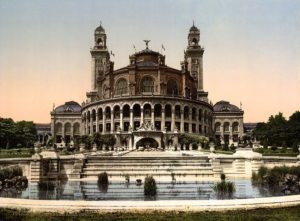
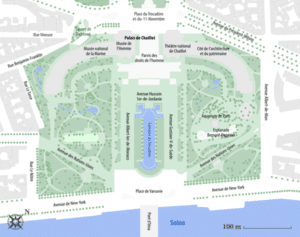
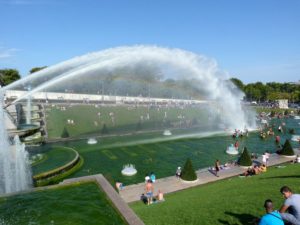
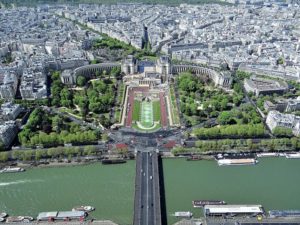

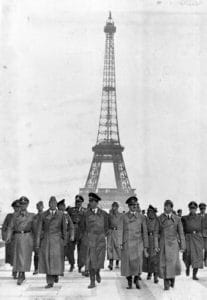
Add a review